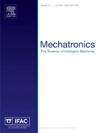Passivity-constrained variable impedance control based on hierarchical decoupling controller for hydraulic manipulators
IF 3.1
3区 计算机科学
Q2 AUTOMATION & CONTROL SYSTEMS
引用次数: 0
Abstract
Impedance control makes the manipulator compliant by regulating the dynamic behavior between the environment and itself. As contact-based applications become more complex, variable impedance control has attracted more attention. However, variable impedance control can cause instability when directly switching impedance parameters, which is a conflict between maintaining the passivity and varying impedance parameters. To solve this conflict, a novel passivity-constrained variable impedance controller for hydraulic manipulators is proposed within the framework of model predictive control. With the impedance relationship and the manipulator dynamics integrated into a prediction model, the proposed strategy utilizes the passivity constraint and the impedance error cost to achieve an optimized tradeoff between passivity guarantee and impedance variation. Furthermore, the inner-loop motion of the hydraulic manipulator is controlled by the hierarchical decoupling controller with the manipulator dynamics and the nonlinearity of the valve-controlled cylinder system considered. The effectiveness of this method was verified by experiments on a heavy-duty hydraulic manipulator. Compared with the traditional method, the proposed method can improve the passivity while ensuring the timely modulation of impedance parameters.
基于层次解耦控制器的液压机械臂无源约束变阻抗控制
阻抗控制通过调节机械臂与环境之间的动态行为,使机械臂具有柔顺性。随着接触式应用的日益复杂,变阻抗控制受到越来越多的关注。但是,在直接切换阻抗参数时,变阻抗控制会引起不稳定,这是保持无源性和改变阻抗参数之间的冲突。为了解决这一矛盾,在模型预测控制的框架下,提出了一种新型的液压机械臂无源约束变阻抗控制器。该策略将机械臂的阻抗关系和机械臂动力学集成到预测模型中,利用无源约束和阻抗误差代价实现无源保证和阻抗变化之间的优化权衡。在此基础上,采用层次解耦控制器对液压机械臂的内回路运动进行控制,同时考虑了机械臂动力学特性和阀控缸系统的非线性特性。以某重型液压机械臂为实验对象,验证了该方法的有效性。与传统方法相比,该方法在保证阻抗参数调制及时的同时,提高了系统的无源性。
本文章由计算机程序翻译,如有差异,请以英文原文为准。
求助全文
约1分钟内获得全文
求助全文
来源期刊

Mechatronics
工程技术-工程:电子与电气
CiteScore
5.90
自引率
9.10%
发文量
0
审稿时长
109 days
期刊介绍:
Mechatronics is the synergistic combination of precision mechanical engineering, electronic control and systems thinking in the design of products and manufacturing processes. It relates to the design of systems, devices and products aimed at achieving an optimal balance between basic mechanical structure and its overall control. The purpose of this journal is to provide rapid publication of topical papers featuring practical developments in mechatronics. It will cover a wide range of application areas including consumer product design, instrumentation, manufacturing methods, computer integration and process and device control, and will attract a readership from across the industrial and academic research spectrum. Particular importance will be attached to aspects of innovation in mechatronics design philosophy which illustrate the benefits obtainable by an a priori integration of functionality with embedded microprocessor control. A major item will be the design of machines, devices and systems possessing a degree of computer based intelligence. The journal seeks to publish research progress in this field with an emphasis on the applied rather than the theoretical. It will also serve the dual role of bringing greater recognition to this important area of engineering.
 求助内容:
求助内容: 应助结果提醒方式:
应助结果提醒方式:


